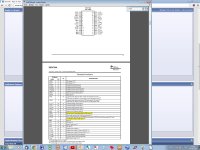Hi all,
So ... hopefully I'm finally close to testing my new DAC with the Amanero (DSD1794 + combo384) board but am a bit unsure of where to connect the pins ... Hope one of you can help with this ...
(I've attached a copy of the relevant datasheet page for the DSD1794)
As far as I can figure out the connections should be as this (for PCM only):
Amanero pin 3: I2S DATA/DSD1 ---> PDATA on the DSD1794
Amanero pin 4: I2S CLK/DSD CLK ---> PBCK on the DSD1794
Amanero pin 5: I2S FSCLK/DSD2 ---> PLRCK on the DSD1794
MCLK (on the combo384) or SCK on the DSD1794 is not to be used .... ?
Assistance is appreciated
Greetings,
Jesper
So ... hopefully I'm finally close to testing my new DAC with the Amanero (DSD1794 + combo384) board but am a bit unsure of where to connect the pins ... Hope one of you can help with this ...
(I've attached a copy of the relevant datasheet page for the DSD1794)
As far as I can figure out the connections should be as this (for PCM only):
Amanero pin 3: I2S DATA/DSD1 ---> PDATA on the DSD1794
Amanero pin 4: I2S CLK/DSD CLK ---> PBCK on the DSD1794
Amanero pin 5: I2S FSCLK/DSD2 ---> PLRCK on the DSD1794
MCLK (on the combo384) or SCK on the DSD1794 is not to be used .... ?
Assistance is appreciated
Greetings,
Jesper
Attachments
I found an old Pedja Rogic TDA1541 non-oversampling dac board, is it a simple matter to connect an Amanero directly to WS,BCK,DATA,GND or isn't as simple as that?
If it is possible anyone know the corresponding connections on Amanero board.
Yes, TDA1541 works with Amanero out of the box.
Connections are rather direct and intuitive -
WS = LRCLK = FS (Frame Sync)
BCLK = BITCLOCK
DATA = DATA
Don't forget to use a ground wire next to each signal wire - use ribbon with the following arrangement:
GSGSGSGSG
where S means signal and G means ground(GND).
Confirmed up to 96kHz material.
192/174kHz doesn't work as the Amanero hit TDA's limitation on BCLK frequency of 5.6MHz (BCLK=32Fs on TDA Vs BCLK=64Fs on Amanero)
Last edited:
Yes, TDA1541 works with Amanero out of the box.
Connections are rather direct and intuitive -
WS = LRCLK = FS (Frame Sync)
BCLK = BITCLOCK
DATA = DATA
Don't forget to use a ground wire next to each signal wire - use ribbon with the following arrangement:
GSGSGSGSG
where S means signal and G means ground(GND).
Confirmed up to 96kHz material.
192/174kHz doesn't work as the Amanero hit TDA's limitation on BCLK frequency of 5.6MHz (BCLK=32Fs on TDA Vs BCLK=64Fs on Amanero)
Thank you, much appreciated.
Has anybody tried the Amanero with a Rasberry Pi yet?
I'm debating getting a RP to try as it could make for a nice, compact media solution, but I've heard there has been problems getting USB audio to work well in the RP.
There are threads about the Rpi elsewhere on DIYaudio, and someone has had reasonable results with the audio widget interface, up to 24/96, with USB 2.0, as long as the devices on the USB bus are all USB 2.0 (I.e. no keyboard connected(which would be USB 1.0))
There are threads about the Rpi elsewhere on DIYaudio, and someone has had reasonable results with the audio widget interface, up to 24/96, with USB 2.0, as long as the devices on the USB bus are all USB 2.0 (I.e. no keyboard connected(which would be USB 1.0))
Thanks for that - I need to do some more digging.
There are threads about the Rpi elsewhere on DIYaudio, and someone has had reasonable results with the audio widget interface, up to 24/96, with USB 2.0, as long as the devices on the USB bus are all USB 2.0 (I.e. no keyboard connected(which would be USB 1.0))
The audio widget thread started intrespersing RPI stuff starting around this post:
http://www.diyaudio.com/forums/digi...b-interface-audio-widget-205.html#post3320020
There's also this dedicated thread:
http://www.diyaudio.com/forums/digital-source/201364-raspberry-pi-new-diyers-digital-hub.html
I have not succeeded in playing completely glitchless music out of my RPI. Maybe I have a dud.
The audio widget thread started intrespersing RPI stuff starting around this post:
http://www.diyaudio.com/forums/digi...b-interface-audio-widget-205.html#post3320020
There's also this dedicated thread:
http://www.diyaudio.com/forums/digital-source/201364-raspberry-pi-new-diyers-digital-hub.html
I have not succeeded in playing completely glitchless music out of my RPI. Maybe I have a dud.
Have you tried strictly headless? That seems to help quite a lot..
Does anyone have a rooted android device with an OTG cable? I'd be interested to know if this will work with that? I'm considering one of these for a car audio interface from an Android based device (Possibly Arndale board, would be Arndale>Amanero>Buffalo III SE>MiniDSP 2x8).
Also is there a group buy currently going on?
Also is there a group buy currently going on?
- Home
- Vendor's Bazaar
- USB to I2S 384Khz - DSD Converter
